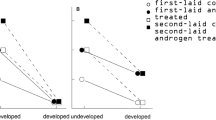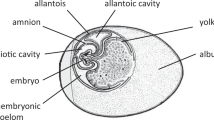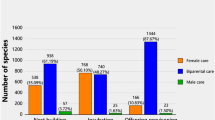Abstract
It has been suggested that female birds put more resources into eggs fathered by attractive males by laying larger eggs1 or by adding more testosterone2, but this inference could be undermined if eggs of different sex are provisioned differently, as these studies did not control for sex differences. Here we compare hormone concentrations in the yolks of male and female eggs and find that these are significantly different. Our results indicate that it is premature to conclude that female birds invest more in eggs sired by a preferred male, and raise the possibility that yolk sex steroids may be part of the sex-determining process in birds.
This is a preview of subscription content, access via your institution
Access options
Subscribe to this journal
Receive 51 print issues and online access
$199.00 per year
only $3.90 per issue
Buy this article
- Purchase on Springer Link
- Instant access to full article PDF
Prices may be subject to local taxes which are calculated during checkout

Similar content being viewed by others
References
Cunningham, E. J. A. & Russell, A. F. Nature 404, 74–75 (2000).
Gil, D., Graves, J., Hazon, N. & Wells, A. Science 286, 126–128 (1999).
Sheldon, B. C., Andersson, S., Griffith, S. C., Ornborg, J. & Sendecka, J. Nature 402, 874–877 (1999).
Burley, N. Evolution 40, 1191–1206 (1986).
Hoyt, D. F. Auk 96, 73–77 (1979).
Schwabl, H. in Perspectives in Avian Endocrinology (eds Harvey, S. & Etches, R. J.) 3–13 (J. Endocrinol., Bristol, 1997).
Jennings, D. H., Weiss, S. L. & Moore, M. C. Am. Zool. (in the press).
Sturkie, P. D. Avian Physiology (Springer, New York, 1986).
Bogart, M. H. J. Theor. Biol. 128, 349–357 (1987).
Crews, D., Cantu, A. R., Rhen, T. & Vohra, R. Gen. Comp. Endocrinol. 102, 317–326 (1996).
Krackow, S. Johannesburg: Bird Life South Africa. Proc. 22nd Int. Ornithol. Congr. (Durban, 1999).
Bowden, R. M., Ewert, M. A. & Nelson, C. E. Proc. R. Soc. Lond. B 267, 1745–1749 (2000).
Schwabl, H. Proc. Natl Acad. Sci. USA 90, 11446–11450 (1993).
Author information
Authors and Affiliations
Corresponding author
Rights and permissions
About this article
Cite this article
Petrie, M., Schwabl, H., Brande-Lavridsen, N. et al. Sex differences in avian yolk hormone levels. Nature 412, 498 (2001). https://doi.org/10.1038/35087652
Published:
Issue Date:
DOI: https://doi.org/10.1038/35087652
This article is cited by
-
Unprecedented high catecholamine production causing hair pigmentation after urinary excretion in red deer
Cellular and Molecular Life Sciences (2019)
-
Maternal influence on eggshell maculation: implications for cryptic camouflaged eggs
Journal of Ornithology (2016)
-
Sex ratio varies with egg investment in the red-necked phalarope (Phalaropus lobatus)
Behavioral Ecology and Sociobiology (2014)
-
Mothers under stress? Hatching sex ratio in relation to maternal baseline corticosterone in the common tern (Sterna hirundo)
Journal of Comparative Physiology A (2013)
-
Faecal sexual steroids in sex typing and endocrine status of great bustards
European Journal of Wildlife Research (2013)
Comments
By submitting a comment you agree to abide by our Terms and Community Guidelines. If you find something abusive or that does not comply with our terms or guidelines please flag it as inappropriate.



